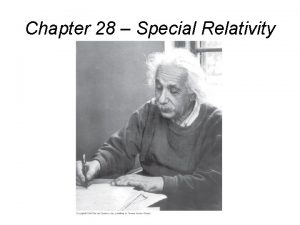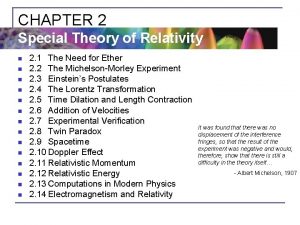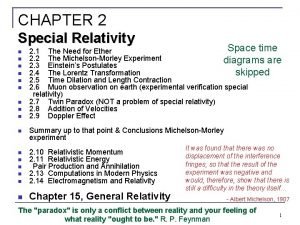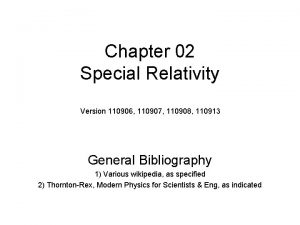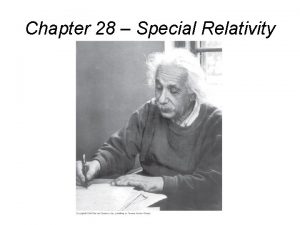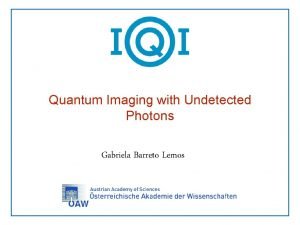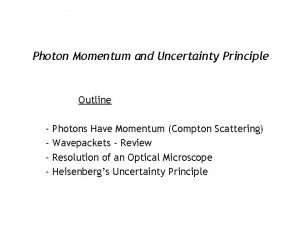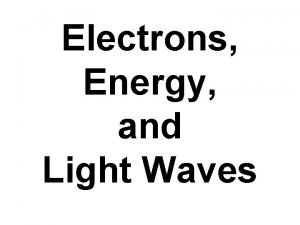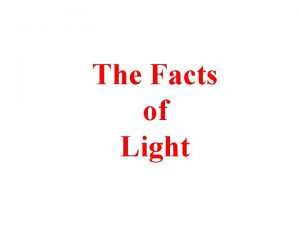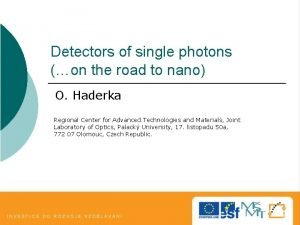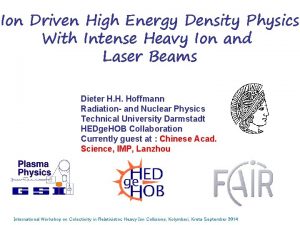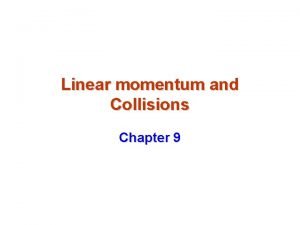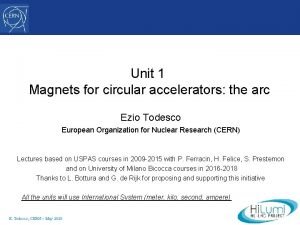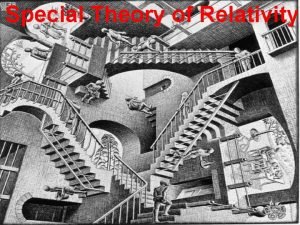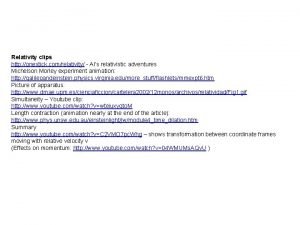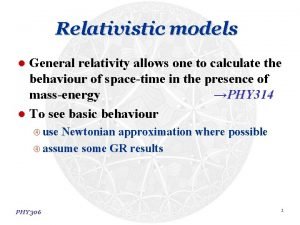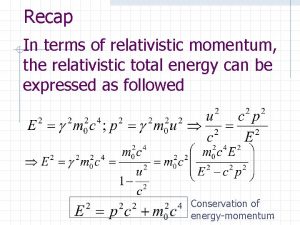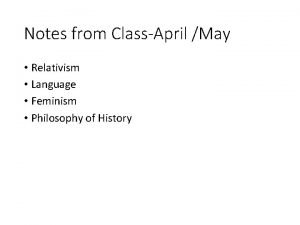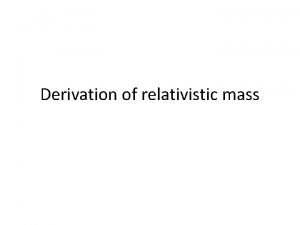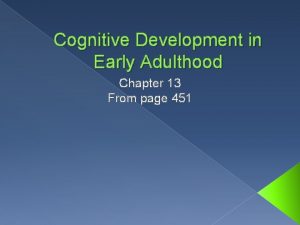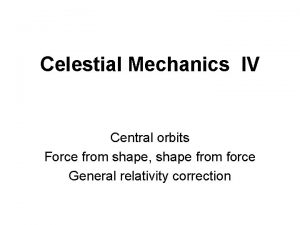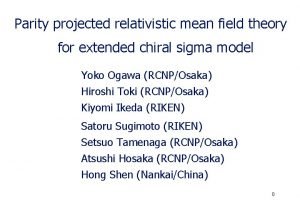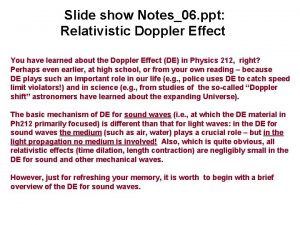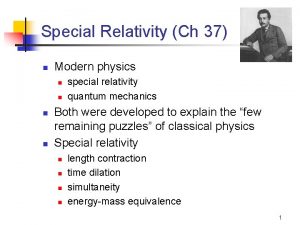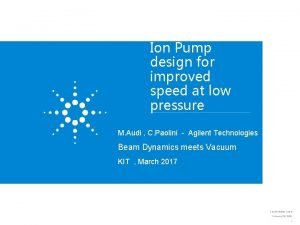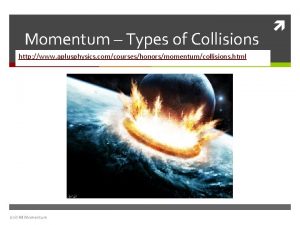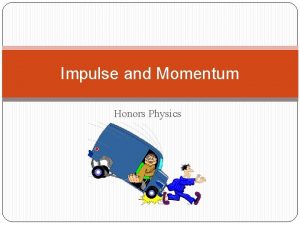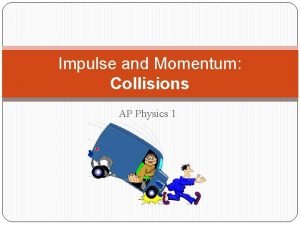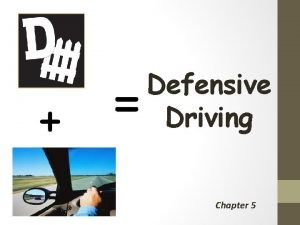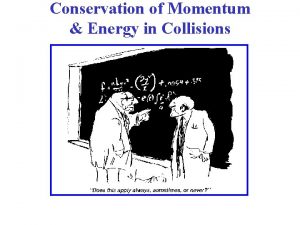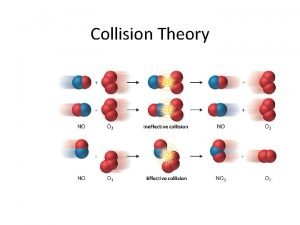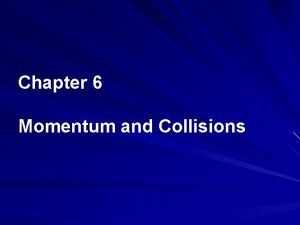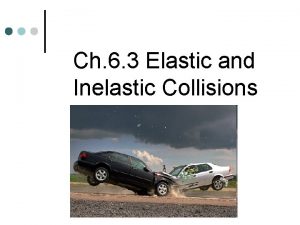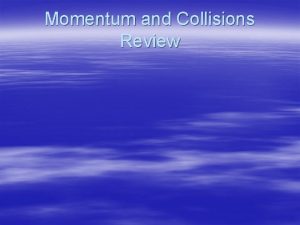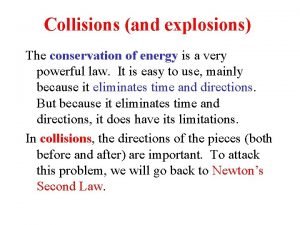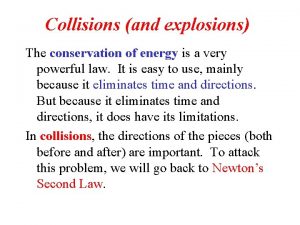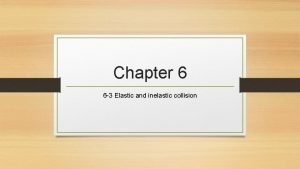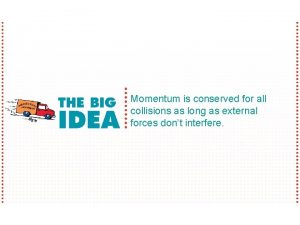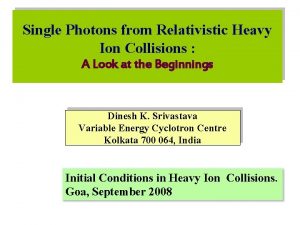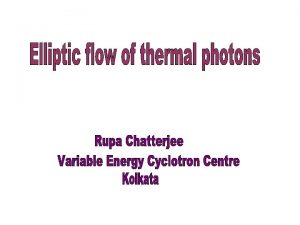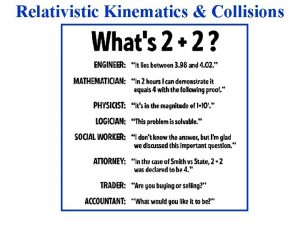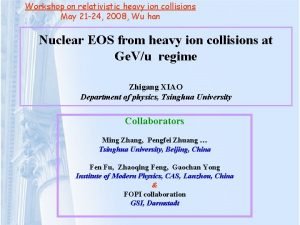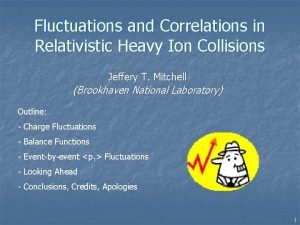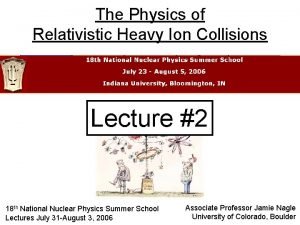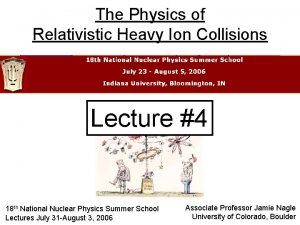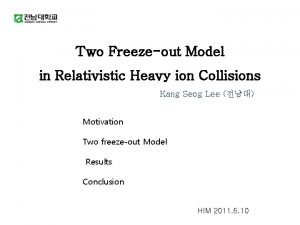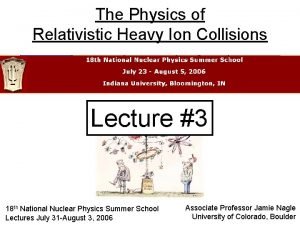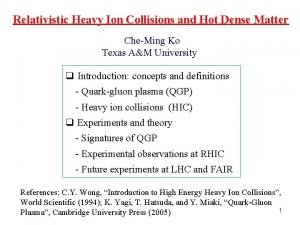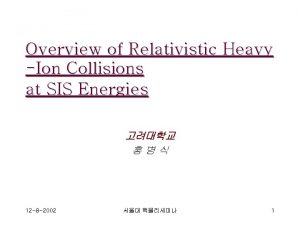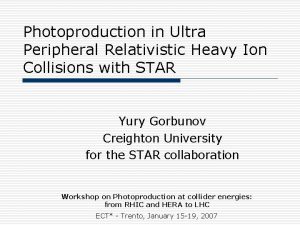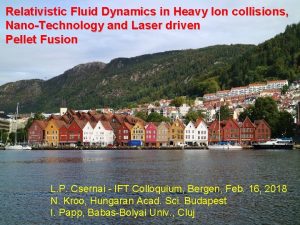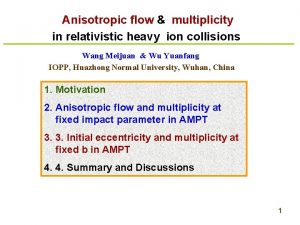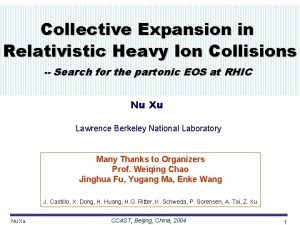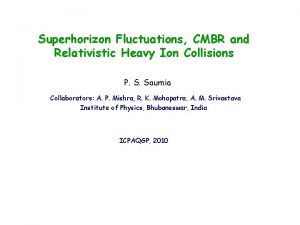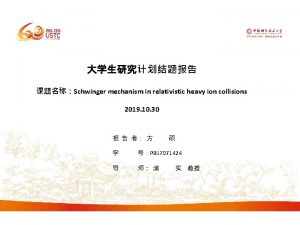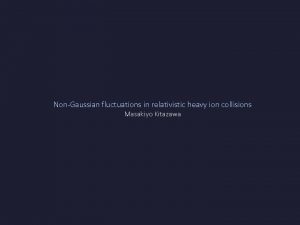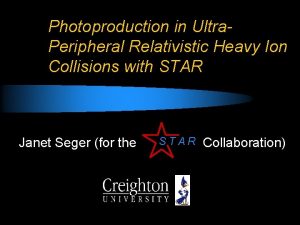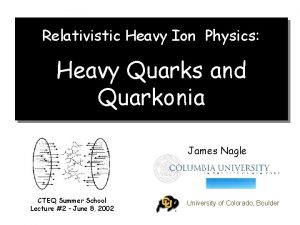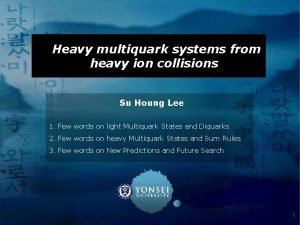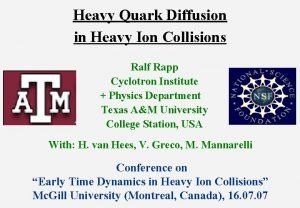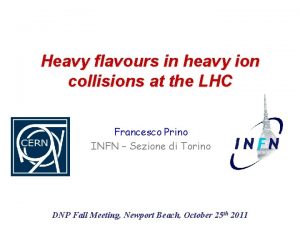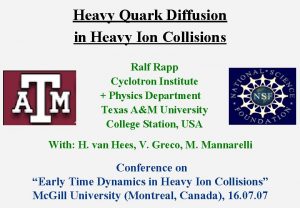High Energy Photons from Relativistic Heavy Ion Collisions















































- Slides: 47

High Energy Photons from Relativistic Heavy Ion Collisions Dinesh Kumar Srivastava Variable Energy Cyclotron Centre Kolkata • • • Motivation The PCM: Fundamentals & Implementation Photon Production in the PCM Medium Effects: Jet-Photon Conversion (FMS Photons) Intensity Interferometry of Photons Elliptic Flow of Thermal Photons WHEPP 2006, Bhubaneswar.


Part #1: Photon Production in the PCM • Light from cascading partons in relativistic heavy-ion collisions - S. A. Bass, B. Mueller and D. K. Srivastava, Phys. Rev. Lett. 90 (2003) 082301 • Semi-hard scattering of partons at SPS and RHIC: A study in contrast -S. A. Bass, B. Mueller, and D. K. Srivastava, Phys. Rev. C 66 (2002) 061902 (R) • Intensity interferometry of direct photons in Au+Au collisions - S. A. Bass, B. Mueller and D. K. Srivastava, Phys. Rev. Lett. 93 (2004) 162301 • Dynamics of the LPM effect in Au+Au Collisions at 200 AGe. V - T. Renk, S. A. Bass and D. K. Srivastava, nucl-th/0505059, Phys. Lett. B. (in press)

Basic Principles of the PCM Goal: provide a microscopic space-time description of relativistic heavy-ion collisions based on perturbative QCD • Degrees of freedom: quarks and gluons • Classical trajectories in phase space (with relativistic kinematics) • Initial state constructed from experimentally measured nucleon structure functions and elastic form factors • An interaction takes place if at the time of closest approach dmin of two partons • System evolves through a sequence of binary (2 2) elastic and inelastic scatterings of partons and initial and final state radiations within a leadinglogarithmic approximation (2 N) • Binary cross sections are calculated in leading order p. QCD with either a momentum cut-off or Debye screening to regularize IR behavior • Guiding scales: initialization scale Q 0, p. T cut-off p 0 / Debye-mass μD

Initial State: Parton Momenta • flavour and x are sampled from PDFs at an initial scale Q 0 and low x cut-off xmin • initial kt is sampled from a Gaussian of width Q 0 in case of no initial state radiation • virtualities are determined by:

Parton-Parton Scattering Cross-Sections gg gg q q’ q g q qbar q’ qbar’ g g q qbar q g q γ qq qq q qbar g γ q qbar γ γ q qbar g g • a common factor of παs 2(Q 2)/s 2 etc. • further decomposition according to colour flow Biswanath Layek working on including heavy quarks.

Initial and Final State Radiation Probability for a branching is given in terms of the Sudakov form factors: Space-like branchings: Time-like branchings: Altarelli-Parisi splitting functions included: Pq qg , Pg gg , Pg qqbar & Pq qγ

Collision Rates & Numbers b=0 fm # of collisions lo full q+q 70. 6 274 q + qbar 1. 3 38. 52 q+g 428. 3 2422. 6 g+g 514. 4 4025. 6 • Lifetime of interacting phase: ~ 3 fm/c • Partonic multiplication due to the initial & final state radiation increases the collision rate by a factor of 4 -10 Are time-scales and collision rates sufficient for thermalization?

Photon Production in the PCM Relevant processes: • Compton: q g q γ • Annihilation: q qbar g γ • Bremsstrahlung: q* q γ ØPhoton yield very sensitive to parton-parton rescattering

What Can We Learn From Photons? • Primary-primary collision contribution to yield is < 10% • Emission duration of preequilibrium phase: ~ 0. 5 fm/c • Photon yield directly proportional to the # of hard collisions • Photon yield scales with Npart 4/3

Photons: pre-equilibrium vs. thermal Øpre-equilibrium contributions are easier identified at large pt: Øwindow of opportunity above pt=2 Ge. V Øat 1 Ge. V, need to take thermal contributions into account Øshort emission time in the PCM, 90% of photons before 0. 3 fm/c Øhydrodynamic calculation with τ0=0. 3 fm/c allows for a smooth continuation of emission rate

HBT Interferometry: Formalism Ø Correlation between two photons with momenta k 1 and k 2 is given by: Ø with S(x, k) the photon source function for a chaotic source Ø use Wigner function scheme (Hansa code by Sollfrank & Heinz) Ø emission vertices of a semiclassical transport are not valid Wigner fnct. Ø need to smear out emission vertices xi by ħ/pi Ø results are given in terms of outward, sideward & longitudinal correlators

Photons: HBT Interferometry • pt=2 Ge. V: prethermal photons dominate, small radii • pt=1 Ge. V: superposition of pre- & thermal photons: increase in radii

Landau-Pomeranchuk-Migdal Suppression The LPM effect accounts for the suppression of radiation due to coherence effects in multiple scattering f b e kt a c • the radiated parton e is assigned a formation time: d • if the radiating parton d suffers a collision before tform has elapsed, then the radiation of parton e and it’s daughters does not take place • likewise for parton f with respect to e …

LPM: Reaction Dynamics gluon pt distribution • high pt: harder slope, enhanced particle production • low pt: suppression of particle production

Photon Production: LPM & Comparison to Data PCM without LPM: • overprediction of photon yield PCM with LPM: • photon yield for pt < 6 Ge. V strongly reduced • strong pt dependence of LPM suppression • good agreement with data

Part #2: Photons via Jet-Plasma Interactions R. J. Fries, B. Mueller, & D. K. Srivastava, PRL 90, 132301 (2003), R. J. Fries, B. Mueller, & D. K. Srivastava, PRC 72, 041902 (R) 2005, See also: S. Turbide, C. Gale, S. Jeon, and G. Moore, PRC 72, 014906 (2005). Dileptons via Jet-Plasma Interactions S. Turbide, C. Gale, D. K. Srivastava, & R. J. Fries, (to be published), hep-ph/0601042

Photon Sources • Hard direct photons • EM bremsstrahlung • Thermal photons from hot medium • Jet-photon conversion Turbide, Gale & Rapp, PRC 69 014903 (2004)


Jet-Plasma Interactions Plasma mediates a jet-photon conversion: Jet passing through the medium: • large energy loss: jet quenching • electromagnetic radiation (real and virtual photons) from jetmedium interactions • suppressed by αEM; negligible as a source of additional jet quenching Ø can escape without rescattering Øuse as probe of energy loss? Ø visible among other sources of electromagnetic signals?

QGP-induced EM Radiation • Annihilation and Compton processes peak in forward and backward directions: • One parton from hard scattering, one parton from thermal medium; Cutoff p , min > 1 Ge. V/c. Ø Photon carries momentum of the hard parton. Ø Jet-photon conversion.

Jet-photon Conversion: Rates • Annihilation and Compton rates: • Thermal medium:

Photons from jet-plasma interaction


FMS Results: Comparison to Data Calibrate p. QCD calculation of direct and Bremsstrahlung photons via p+p data: For pt<6 Ge. V, FMS photons give significant contribution to photon spectrum: 50% @ 4 Ge. V Fries, Mueller, & Srivastava, PRC 72, 041902 (R) 2005

FMS: Centrality Dependence and Jet-quenching • Centrality dependence well described • Effect of energy-loss on jets before conversion ~ 20% (Turbide et al).

FMS Photons: Further Confirmations S. Turbide and C. Gale, hep-ph/0512200

Azimuthal Anisotropy of FMS Photons S. Turbide, C. Gale, and R. J. Fries, hep-ph/0508201.


Jet-plasma or jet-thermal dileptons




Application: Monitoring Jet Quenching Full jet reconstruction not possible at RHIC: • Measure suppression of single inclusive hadron spectra (compare to p+p baseline) • Better: photon-tagged (Wang & Sarcevic) or dilepton – tagged jets (Srivastava, Gale, & Awes): ü q+g q+ : recoil photon knows the initial energy of the jet ü Measure energy loss of quark as a function of quark energy E • Photons from jet-photon conversion provide a third, independent measurement. (FMS) ü Better handle on the L dependence of energy loss ü Jet-photon conversion is background for photon tagged jets

Part #3: Elliptic flow of thermal photons Elliptic Flow of Thermal Photons in Relativistic Heavy Ion Collisions, Rupa Chatterjee, Evan S. Frodermann, Ulrich Heinz, and D. K. Srivastava, nucl-th/0511079. Photons are emitted from every point in space and time unlike hadrons which come out only from freeze -out surface, when the fluid element is at 100 Me. V !

Nuclear Fluid Dynamics • Transport of macroscopic degrees of freedom • Based on conservation laws: μTμν=0, μjμ=0 • For ideal fluid: Tμν= (ε+p) uμ uν - p gμν and jiμ = ρi uμ • Equation of State needed to close system of PDE’s: p=p(T, ρi) • assume local thermal equilibrium • Initial conditions (i. e. thermalized QGP) required for calculation • Simple case: scaling hydrodynamics – – assume longitudinal boost-invariance cylindrically symmetric transverse expansion no pressure between rapidity slices conserved charge in each slice

Collective Flow: Overview • Directed flow (v 1, px, dir) – spectators deflected from dense reaction zone – sensitive to pressure • Elliptic flow (v 2) – asymmetry out- vs. in-plane emission – emission mostly during early phase – strong sensitivity to Eo. S • Radial flow (ßt) – isotropic expansion of participant zone – measurable via slope parameter of spectra (blue-shifted temperature)



Elliptic Flow: Theory & Experiment • Data from STAR & PHENIX • Good agreement between hydro and pt-differential data • Data saturates for high pt Kolb & Heinz hep-ph/0204061 D. Teaney, J. Lauret, E. Shuryak nucl-th/0110037 Hydro+Micro: • strong sensitivity to QGP Eo. S • includes proper flavour dynamics • self-consistent freeze-out

Does v 2 Reflect Parton Flow? Recombination model suggests that hadronic v 2 reflects parton v 2 : P. Soerensen, UCLA & STAR @ SQM 2003 Ø measurement of partonic v 2 !

Contours of Constant Energy Density

For central collisions these will be identical.

Eliiptic Flow of Thermal Photons

Centrality Dependence : Elliptic Flow of Thermal Photons

Summary Photon Production in the PCM: • Photon yield very sensitive to parton rescattering Ø LPM effect needed for proper description of reaction dynamics • HBT experimentally challenging, but feasible with high statistics data sets Ø calculable in the framework of PCM and hydrodynamics Ø short emission duration in pre-equilibrium phase: small radii at high pt Ø larger source at later times due to emission of thermal photons Contd. . .

Photon Production via Jet-Medium Interactions: • jet-photon conversion may contribute up to 50% @ 4 Ge. V to photon yield • results compatible with PHENIX data (centrality dependence, RAA) • analogous process for virtual photons: contribution to dilepton production • azimuthal asymmetry of the initial shape of hot & dense fluid. Elliptic Flow of Thermal Photons: Large p_T; QGP, small p_T; hadronic phase!
 Relativistic kinetic energy
Relativistic kinetic energy Kinetic energy of a relativistic particle
Kinetic energy of a relativistic particle Rest energy of a proton
Rest energy of a proton Relative speed of approach
Relative speed of approach Relativistic kinetic energy
Relativistic kinetic energy What does ratey stand for
What does ratey stand for Quantum imaging with undetected photons
Quantum imaging with undetected photons Do photons have momentum
Do photons have momentum Energy planck's constant
Energy planck's constant Facts of light
Facts of light Single photon detector
Single photon detector Heavy ion
Heavy ion Loss of energy in collision
Loss of energy in collision C6h12 fuerza intermolecular
C6h12 fuerza intermolecular Qumica
Qumica Dipolos instantaneos
Dipolos instantaneos London dispersion forces
London dispersion forces Relativistic circular motion
Relativistic circular motion Relativistic thinking example
Relativistic thinking example Relativistic mass
Relativistic mass Bertrand postulate
Bertrand postulate Relativistic acceleration calculator
Relativistic acceleration calculator Relativistic momentum
Relativistic momentum Relativistic thinking example
Relativistic thinking example Relativistic mass formula
Relativistic mass formula Labouvie-vief pragmatic thought
Labouvie-vief pragmatic thought Clairaut equation
Clairaut equation Cognitive development in early adulthood
Cognitive development in early adulthood Relativistic mean field theory
Relativistic mean field theory Doppler effect animation ppt
Doppler effect animation ppt Relativistic momentum
Relativistic momentum High pumping speed large ion pump
High pumping speed large ion pump Types of collision
Types of collision Inelastic collision
Inelastic collision Impulse and momentum relation
Impulse and momentum relation Collisions ap physics 1
Collisions ap physics 1 To avoid collisions a defensive driver should
To avoid collisions a defensive driver should Energy lost in inelastic collision
Energy lost in inelastic collision A freight train is being assembled in a switching yard
A freight train is being assembled in a switching yard Necessary for successful collisions to occur
Necessary for successful collisions to occur Types of collisions
Types of collisions Types of collisions
Types of collisions A roller coaster climbs up a hill at 4m/s and then zips
A roller coaster climbs up a hill at 4m/s and then zips Collisions and explosions
Collisions and explosions Collisions and explosions
Collisions and explosions Elastic collision video
Elastic collision video Is momentum conserved in all collisions
Is momentum conserved in all collisions Expressways have fewer collisions than highways because
Expressways have fewer collisions than highways because
